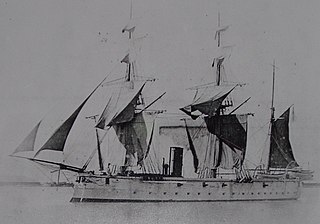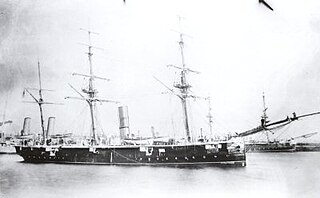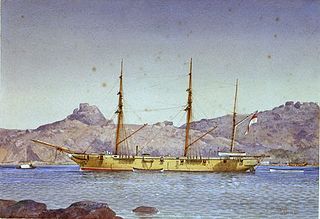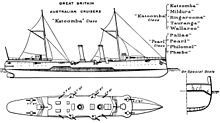
The capital ships of a navy are its most important warships; they are generally the larger ships when compared to other warships in their respective fleet. A capital ship is generally a leading or a primary ship in a naval fleet.

HMS Kingfisher was a Doterel-class screw sloop of the Royal Navy. She was built at Sheerness Dockyard and launched on 16 December 1879. She conducted anti-slavery work in the East Indies in the late 1880s before being re-roled as a training cruiser, being renamed HMS Lark on 10 November 1892, and then HMS Cruizer on 18 May 1893. She was sold in 1919.

HMS Mildura was a Pearl-class cruiser built for the Royal Navy in the late 1880s. Originally named HMS Pelorus, she was renamed after an Australian town in April 1890. Per the Imperial Defense Act of 1887, she served primarily in Australian waters.

The Bacchante class was a group of three iron screw corvettes in service with the Royal Navy from the late 1870s.

The Camelion class was a class of screw-driven sloops of wood construction, designed by Isaac Watts and operated by the Royal Navy. Eight ships of the class were built from 1858 to 1866 with another eight cancelled. They were initially rated as second-class sloops, but were later reclassified as corvettes.

The Amazon class was a class of six screw sloops of wooden construction built for the Royal Navy between 1865 and 1866.

The Beagle class was a two-ship class of 8-gun screw steel sloops built for the Royal Navy in 1889.

The Mariner class was a class of six 8-gun gunvessels built for the Royal Navy between 1883 and 1888. Four were built in the Naval Dockard at Devonport, and two elsewhere; the Acorn was built by contract at Jacobs Pill on the Pembroke River, while the Melita was built in the Malta Dockyard, the only substantial ship of the Royal Navy ever to be built in the island.

The Satellite class was a class of 12-gun composite sloops built for the Royal Navy between 1883 and 1888, and reclassified as corvettes in 1884.

HMS Torch was an Alert-class sloop of the Royal Navy, built at Sheerness Dockyard and launched in 1894. She served in Australia and New Zealand and was transferred to New Zealand as a training ship in 1917, being renamed HMS Firebrand at the same time. She was sold in 1920 and converted to a refrigerated ship with the new name Rama. She ran aground in the Chatham Islands in 1924 and was abandoned.

HMS Katoomba was a Pearl-class cruiser built for the Royal Navy, originally named HMS Pandora, built by Armstrong Whitworth, Elswick, Tyne and Wear and launched on 27 August 1889. Renamed on 2 April 1890, as Katoomba as the flagship of the Auxiliary Squadron of the Australia Station. She arrived in Sydney with the squadron on 5 September 1891. She was damaged in a collision with the tug Yatala in Port Adelaide on 29 December 1891. She left the Australia Station on 16 January 1906. She was sold for £8500 on 10 July 1906 and broken up at Morecambe.

HMS Ringarooma was a Pearl-class cruiser of the Royal Navy, originally named HMS Psyche, built by J & G Thomson, Glasgow and launched on 10 December 1889. Renamed on 2 April 1890, as Ringarooma as part of the Auxiliary Squadron of the Australia Station. She arrived in Sydney with the squadron on 5 September 1891. She was damaged after running aground on a reef at Makelula Island, New Hebrides on 31 August 1894 and was pulled off by the French cruiser Duchaffault. Between 1897 and 1900 she was in reserve at Sydney. On 15 February Captain Frederick St. George Rich was appointed in command. She left the Australia Station on 22 August 1904. She was sold for £8500 in May 1906 to Forth Shipbreaking Company for breaking up.

HMS Tauranga was a Pearl-class cruiser of the Royal Navy. The vessel was originally named Phoenix and built by J & G Thomson, Glasgow. She was launched on 28 October 1889. Renamed on 2 April 1890, as Tauranga as part of the Auxiliary Squadron of the Australia Station. She arrived in Sydney with the squadron on 5 September 1891. During the Samoan civil war in 1899, she took part in operations with HMS Porpoise and HMS Royalist. Spending between 1901 and 1903 in reserve at Sydney before being assigned to the New Zealand division of the Australia Station. She left the Australia Station on 14 December 1904. She was sold for £8500 in July 1906 to Thomas Ward for breaking up.

HMS Wallaroo was a Pearl-class cruiser built for the Royal Navy, originally named HMS Persian, built by Armstrong, Mitchell, Elswick, Newcastle upon Tyne and launched on 5 February 1890.

The Racer-class sloop also known as the Cordelia class of swift cruisers was an 11-gun wooden screw sloop class of five ships built for the Royal Navy between 1855 and 1860.

HMS Nymphe was an Amazon-class sloop, of the Royal Navy, built at the Deptford Dockyard and launched on 24 November 1866. She served in the East Indies and Australia, and was sold in 1884.

HMS Phoebe was a Pearl-class cruiser of the Royal Navy, in service from the early 1890s until 1906.

HMS Mutine was a Condor-class sloop of the Royal Navy. Mutine was launched on 1 March 1900. While being delivered from Birkenhead to Portsmouth an accident in Mutine's boiler rooms caused some loss of life and gave her a name as an unlucky ship before her career even began. She served on the China Station, then the Australia Station between December 1903 and February 1905 and later became a survey ship, surviving until 1932 as a Royal Naval Volunteer Reserve drill ship, the last of her class to be sold.
The Snake-class ship-sloops were a class of four Royal Navy sloops-of-war built in the late 18th and early 19th centuries. Though ships of the class were designed with the hull of a brig, their defining feature of a ship-rig changed their classification to that of a ship-sloop rather than that of a brig-sloop.

The Jason-class corvette was a type of wooden screw corvette made between 1859 and 1863. There were a total of seven ships of this class made by the authorization of the Royal Navy.





















